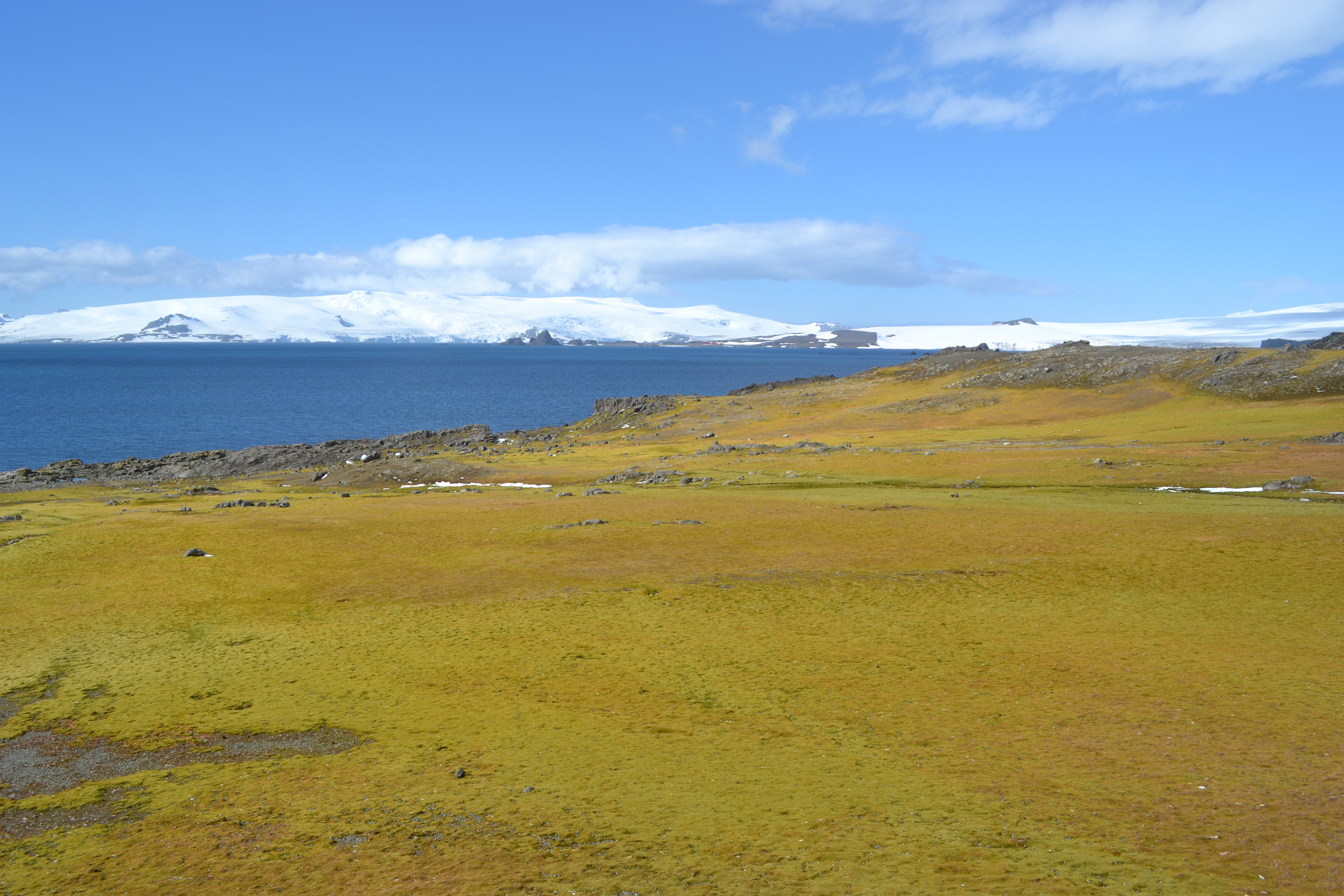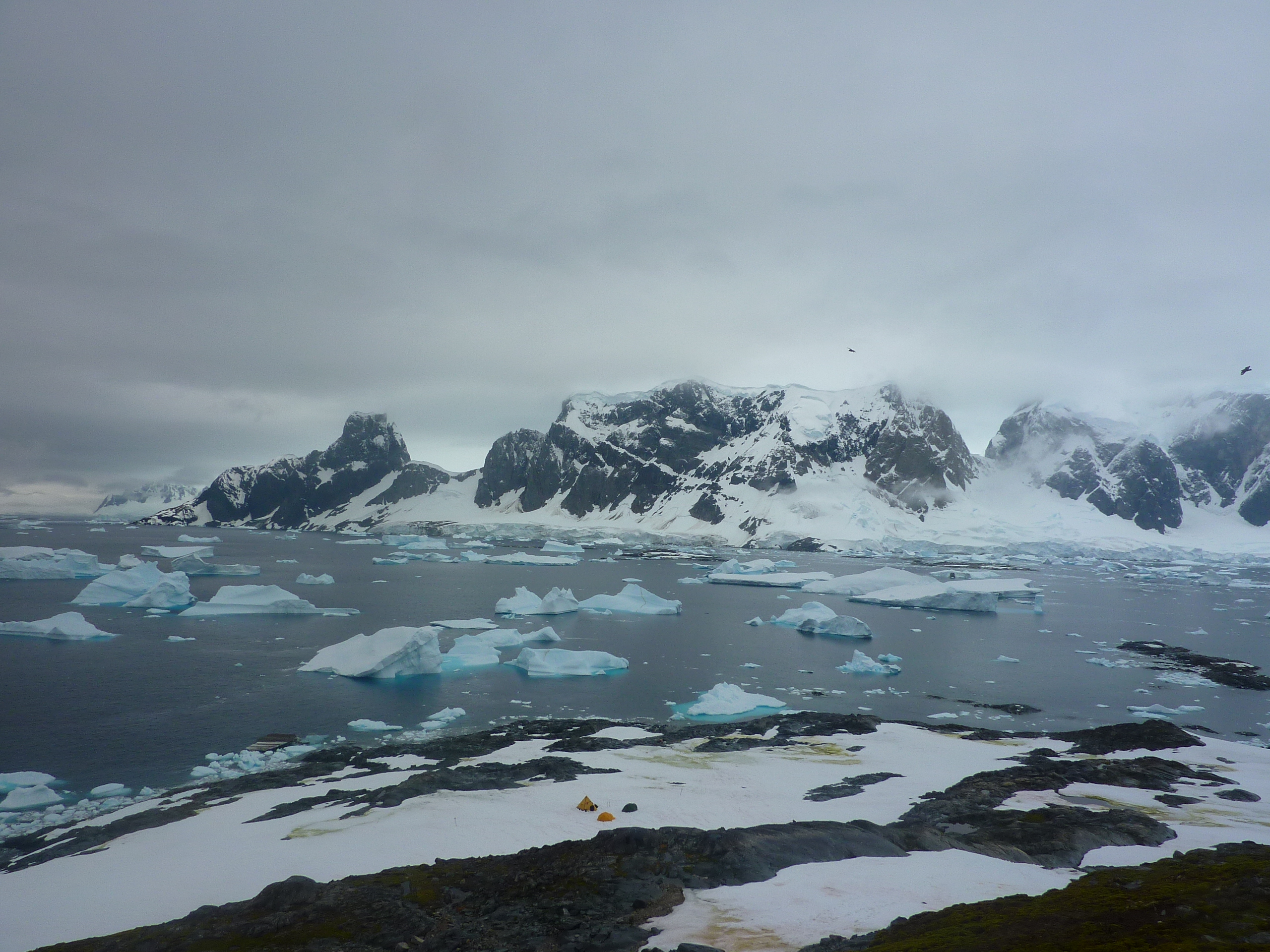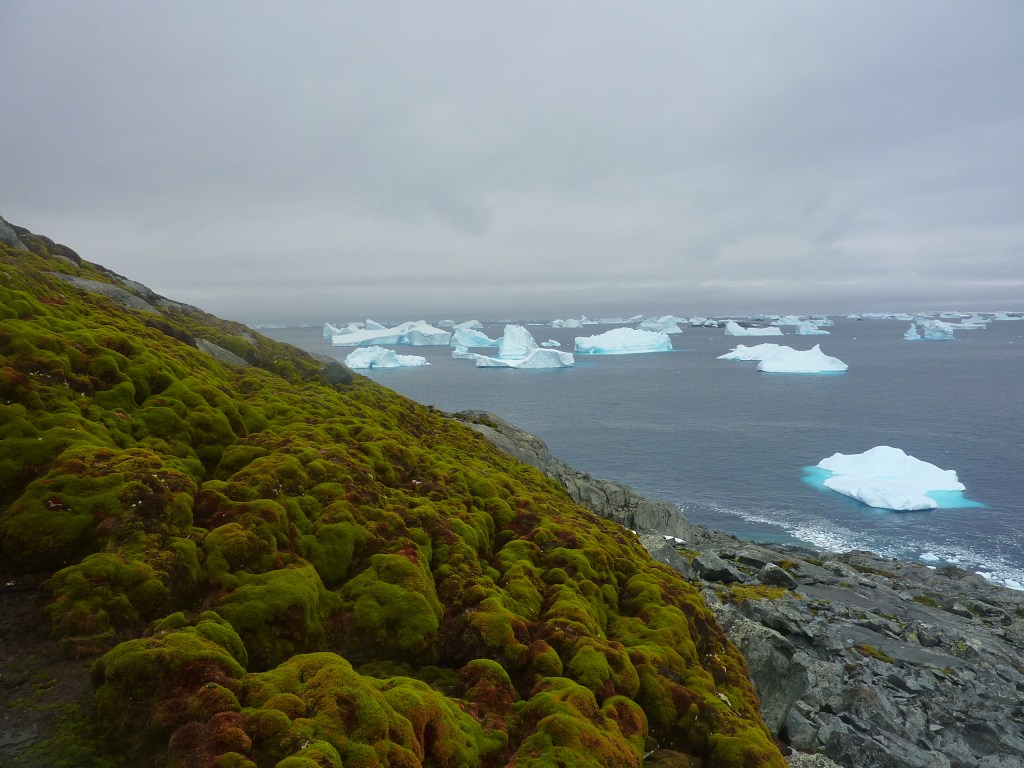Our world’s climate is changing, we have changed it, and now we need to prepare for what’s next. The ends of the earth are ground zero for understanding these changes.
If you walk down to the sliver-moon shaped beach in Bahia Thetis, Tierra del Fuego, Argentina, paddle out into the small bay there (mind the seal lions, who love this protected spot) and then turn south, you’ll soon be navigating the icy waters of the Scotia Sea. Continue for about — um — 750 miles, dodging the serenely floating icebergs that dot the sea, and aim for Green Island, one of many outposts off the Antarctic peninsula.
Videos by VICE
When you arrive on the shores of the island, look for its namesake color. It should be easy to spot, because most of the environment is greyscale, from the white of the glacier ice to the dark grey of the sea and rocks. The hopeful green color you might instinctively be hiking towards isn’t one thing, though, it’s many: it comes via the millions of mosses that grow on the edges of the Antarctic peninsula. You are lucky to have found any green at all: only 1 percent of the Antarctic is able to host plant life.
These mosses can tell us an important story, and are a piece of a much-larger puzzle. Each winter, these wee plants—some of the tiniest on earth—freeze solid, the extreme cold preserving that growth, forming layers of self-upon-self.
This layering means that scientists can look back in time at this reliable record, by pulling cores from the deep within the permafrost layers (only about the top foot of the moss is unfrozen, even in the summer), with each layer representing a year’s worth of growth. Scientists can see thousands of years of moss growth in this way. Since the 1950s, the mosses have grown faster—around 3 millimeters a year, compared to previous averages of about 1 millimeter.
Importantly, how much the mosses grow once spring arrives is dependent on the length of their growing season—not how hot it gets in the summer. “The largest increases in recorded temperature have occurred during the winter, spring, and autumn periods, which suggests that changing temperature has had the greatest impact on biological productivity during the shoulder periods of the growing season,” writes Dr. Matt Amesbury of the University of Exeter and his research team in a recent Current Biology journal article.
Check out some more videos from VICE:
All of the above—the location, the mosses’ life cycle, the longevity of their growth record, mean that these plants are another way to reify climate change and its impacts in the Antarctic, where change is happening faster than most other places. With most credible scientists saying we are just beginning to see the effects of CO2 on our climate, this gives us a glimpse into the future: “Longer term, warming is expected to continue,” says Amesbury. “We’ve shown that when that does happen, the mosses will respond quickly.”
Along with the mosses and lichens that are the first to colonize the areas that are left ice-free after glaciers retreat, two species of vascular plants, the Antarctic hairgrass and Antarctic pearlwort, are also growing in the area, though they don’t leave records like the moss does. “Recent studies have shown that their distribution and local abundance has also increased over similar timescales to those used in our study, so we would expect them to play their part in a future greening,” says Amesbury.
By the time we’re thinking of camping out in the woods of the Antarctic, other changes will have taken place too.
Greening is already well on its way in other parts of the planet: In a 2016 study in Nature, a group of 32 researchers in eight countries collaborated to show a “persistent and widespread increase of growing season integrated LAI (greening) over 25 percent to 50 percent of the global vegetated area,” according to long-term satellite leaf-indexes from 1982-2009. The scientists determined that about 70 percent of that extra growth came from “CO2 fertilization,” while 9 percent was explained by more nitrogen, 8 percent by climate change, and 4 percent by land cover change (in the US, we now actually have more trees now than 100 years ago.) At the same time, fewer than 4% of green areas browned in the same time period.

Strikingly green moss carpet on Barrientos Island, South Shetland Islands. (Photo via Dan Charman)
Dr. Amesbury says that the results he and his team found are a good regional example of these wider global trends. “We could certainly say the same for moss growth on the Antarctic Peninsula, in response to temperature changes, themselves driven by human-induced changes in atmospheric CO2 concentration as well as changes in the ozone layer,” Amesbury says.
You might remember the term “succession” from high school biology class: When an area is wiped clean, via fire, flood, tilling a field, or, in the case of the Antarctic, because land is uncovered that hasn’t been laid bare to the sun in 10,000 years or more, certain types of plants move in first—pioneer species. Others follow, in a predictable pattern, and then finally trees show up, until an ecosystem reaches a mature forest (what specific mosses, grasses, bushes, trees, etc. grow in a given location depends on local species, but some type of succession happens almost everywhere plants can grow). In the case of the laid-bare new ground in the Antarctic, the mosses are our pioneers.
So, how do we save ourselves? Keeping warming below 2 degrees Celsius is imperative.
So does that mean that the future of the Antarctic is one that’s verdant, maybe even forested, replacing the harsh, icy world that today still stands? It’s possible—this area was indeed forested during the Cretaceous era, (145 million years ago to 65 million years ago). We are well on our way: Current CO2 levels are already at levels the earth last felt 3 million years ago, during the Pliocene epoch.
Read more: The Power of Arts and Music Turn the Tide on Ocean Conservation
This may not sound like such a bad repercussion of climate change, but keep in mind, by the time we’re thinking of camping out in the woods of the Antarctic, other changes will have taken place too. Oceans will have risen so high due to all that ice melting that places like Green Island—and any life it might one day contain—will be submerged beneath the less-icy seas. Along with most of our coastal cities, towns, and islands. Weather patterns will shift dramatically, so we won’t be able to rely on areas we have dependably farmed for hundreds of years. Animal and plant species we rely on may be wiped out. And then there’s the terrifying “things that we know we don’t know”: repercussions that we can’t even predict. And all of this happening on the hyper-accelerated timeline that we are on (previous warming and cooling cycles have taken places over tens of thousands of years, not hundreds) means we—and the rest of life on earth—will have precious little time to adapt.

View from the summit of Green Island moss banks with fieldwork camp and general context of island. (Photo via Matt Amesbury)
It’s not “the planet” that will be destroyed by climate change—it is already adapting to the heavy burden of our CO2 emissions, as the mosses have shown. It is humans who will suffer the most from the coming changes, as the very rapid changes due to our actions change the surface of the earth to one that makes it much harder for us to live on—and is especially punishing to those who already live on the margins. We will all be climate refugees.
So, how do we save ourselves? Keeping warming below 2 degrees Celsius is imperative says the European Geosciences Union, which looked at the differences between a 1.5 degree rise in global temperatures, and just half a degree more. As Bob Silbing , at NASA’s Jet Propulsion Laboratory wrote, “At 1.5 C, the study found that tropical coral reefs stand a chance of adapting and reversing a portion of their die-off in the last half of the century. But at 2 C, the chance of recovery vanishes. With a 1.5 C rise in temperature, the Mediterranean area is forecast to have about 9 percent less fresh water available. At 2 C, that water deficit nearly doubles. So does the decrease in wheat and maize harvest in the tropics.”
So the actions we take—or don’t take—right now have very serious impacts. So vote, vote, vote—in every election you can. Support the cities’ mayors that are leading on mitigating climate change in the face of Trump’s withdrawal from the Paris climate agreement. And yeah, throwing a solar panel on your roof, eating (a lot) less meat, and choosing a fuel-efficient car over a truck or SUV (even better: an electric car) are the top three things that you can do personally that will make the biggest dent in your carbon emissions. You’ll save some cash with those changes too. It all amounts to pretty minor adjustments—at the government level all the way down to your own—to avoid worst-case scenarios, and the unpredictability of what we don’t know.
More
From VICE
-

Illustration by Reesa -

(Photo by Carl Court/Getty Images) -

Collage by VICE -

Collage by VICE
